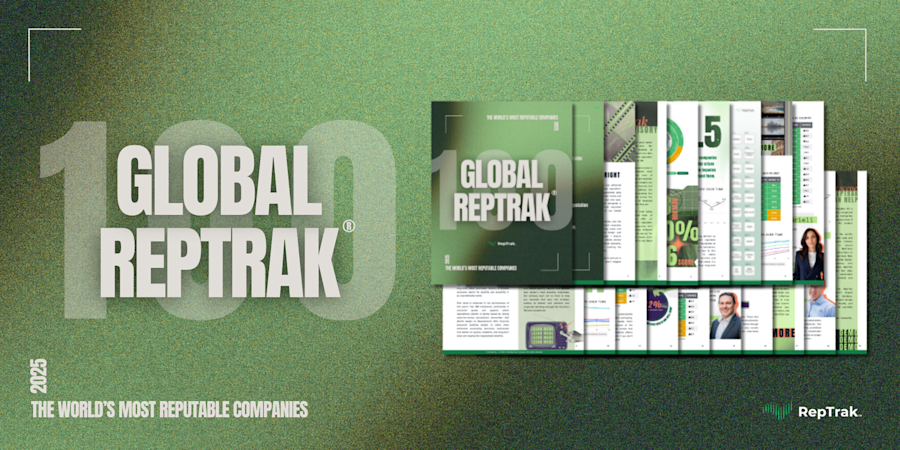Navigating Communications During the Pandemic? A Holistic Reputation Management Approach Can Help
Blog Post10 Dec, 2020
Companies faced many challenges in the global misery that was 2020, including managing their corporate reputations in the midst of a pandemic. Unfortunately, most organizations monitored only their brand (i.e., their internally created image). This left them with a blind spot in terms of reputation (i.e., how the public perceives them). Just because a company wants its customers to think of it as “empathetic,” for example, doesn’t mean they will.
Today’s consumers want to know that the companies they buy from behave ethically and transparently, treat their employees well, and cast an inspiring vision for the future. Prioritizing communications and marketing won’t cut it when only 4% of people trust advertising. Even offering a great product or service isn’t enough. You have to examine your holistic corporate reputation.
What Is a Holistic Reputation Management Approach?
To start, your reputation is driven by seven cognitive considerations:
• Products and services
• Innovation
• Workplace
• Governance
• Citizenship
• Leadership
• Financial performance
A holistic reputation management approach looks at and quantifies these seven areas plus how your brand is expressed; your media score; and your environmental, social, and corporate governance (ESG) score. These metrics are tangible and can help you understand how reputation is tied to how people feel about you, what they think about your media coverage, and more.
To get objective results, it’s important to use machine learning to process and normalize the data. Machine learning removes human bias and makes the process scalable. After all, reputation is fluid — it’s not a one-and-done analysis. You have to continuously compare your results against your industry and competitors to know what actions to take. Only when you do this will you have a full picture of your reputation intelligence and management.
How to Manage Corporate Reputation With a Holistic, Data-Backed Approach
As 2020 has proven, corporate reputation and consumer perception can shift rapidly over the course of a year, which is why it’s important to understand how they impact your business. If you don’t, you run the risk of losing your customers, revenue, and competitive advantage. Although the steps below aren’t groundbreaking, they’re recommended by our top-notch team of data analysts. Here’s how you can improve your corporate reputation:
1. Prove that you have high-quality products and services.
Consumers have experienced major changes throughout 2020, but they continue to want products and services they can rely on. Anyone can say they’re the best, but consumers might not agree. Trust is a major component of consumer perception, and one obvious way to establish trust is by always highlighting customer satisfaction. Showcase positive reviews, talk about recent awards, and always proactively respond to complaints and compliments. After all, 71% of people are more likely to buy from a business if the company responds to reviews. Consistency differentiates companies in a highly competitive marketplace.
2. Support your workforce and communicate helpful information.
In 2020, people placed greater importance on safe workplaces. That’s why you should treat your employees as key stakeholders who have an impact on your reputation performance score. It’s a challenging year, and your team members need you. The more you support your workforce, the sooner you’ll reach your business objectives and outpace the competition. Ways to demonstrate your support could include letting employees know what policies they can take advantage of and instructing them on how to apply for certain benefits. Just remember that you also have to communicate what your company is doing to create a safe workplace. Otherwise, you won’t get the credit.
3. Treat your customers as more than dollar signs.
Actions speak louder than words, so make sure your company prioritizes its mission, not its revenue. Audiences value businesses that support them, especially during difficult times. Allstate, for example, provided a payback check for customers sheltering in place during the pandemic and not driving as frequently.
Aggressive strategies and “buy now” messaging come off as thoughtless when customers face financial hardships. Focus instead on ways to serve your community, for example, by contributing to COVID-19 research efforts or by donating to local food banks. And again, don’t forget to relay what you’re doing to customers and stakeholders. At RepTrak, we found through our joint study with American Banker that banks’ reputations only increased after they communicated how they helped customers.
4. Cater to your loyal customers.
It is five times more expensive for companies to acquire customers than to keep current ones. Caring for existing customers gives you a cushion to hit your 2020 goals even if finding new buyers is harder in 2021 because of pandemic-induced uncertainty. Make sure current customers have all the positive information about your company and encourage them to share it. Consumers are more willing to buy from and work for companies with higher corporate reputations, according to our 2020 Global RepTrak study, so favorable consumer perceptions will lead to more new customers.
One of the biggest mistakes you can make this year is focusing only on your brand. Yes, brand is an important part of your reputation, but it’s not enough on its own. Unless you look at your holistic corporate reputation, you don’t know if people will trust you, recommend you, give you the benefit of a doubt, etc. Brand tells you whether people know your organization, not whether they like you.
RepTrak is here to determine what drives your reputation and help you take your company to the next level. Request a demo of RepTrak’s platform to learn how you can use it to improve your company’s corporate reputation in 2021.





